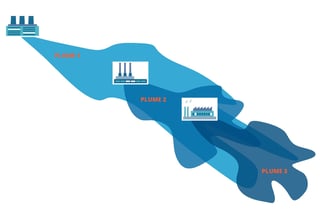Written by Kelli Hicks, Project Manager, who works for BBJ Group's Compliance Practice in our Chicago, IL office.
By BBJ Group June 06, 2017
Written by Kelli Hicks, Project Manager, who works for BBJ Group's Compliance Practice in our Chicago, IL office.
In April 2017, the much-anticipated “Commingled Plume Technical Guidance Document” (Commingled Plume Guidance) was released by the New Jersey Department of Environmental Protection (NJDEP). As one of the first of its kind, this Guidance specifically addresses technical and administrative approaches for commingled plumes that will be helpful to property owners and investigators around the country.

A commingled plume, or mixed plume, is when contaminants from two or more distinct discharges mix in the underlying groundwater. These commingled plumes are often more difficult and complicated to clean up than single plumes.
Commingled plumes are common in densely developed areas and can arise from multiple different scenarios. Here are two basic examples of how commingled plumes are formed:
Example 1: Neighboring gas stations both had fuel spills and the underlying groundwater is contaminated with gasoline from both facilities.
Example 2: A neighboring gas station and dry cleaner each had releases and the underlying groundwater is contaminated with both dry cleaning solvents and gasoline.
The sources can be spatially distinct (i.e. originated from different locations) or temporally distinct (i.e. occurred at different times).
Every commingled plume is unique and presents its own challenges for cleanup. If the commingled plume has multiple contributors, also known as potential responsible parties (PRPs), it can be hard to determine the limits of each individual plume. This can make choosing a remedial strategy and allocating each PRPs “fair share” of the cleanup difficult.
In Example 1 above, the contaminants are similar and so the challenge for the investigator is delineating the individual plumes in order to assign responsibility between the PRPs.
In Example 2 above, the contaminants are different, so it will likely be easier for investigators to separate the individual contributing plumes; however, the PRPs may need to work cooperatively when designing remedial strategies so as not to hinder the cleanup of one or more of the differing contaminants.
The Commingled Plume Guidance uses a dual technical and administrative approach to help investigators.
Technical techniques to delineate the individual plumes that are discussed in the Commingled Plume Guidance include:
A helpful checklist is included in the Guidance for the investigator that identifies the information or potential lines of evidence that could be collected to assist with plume delineation and source identification.
The Commingled Plume Guidance provides advice on working with other PRPs, including benefits and challenges of working cooperatively to clean up the commingled plume, options for dealing with uncooperative PRPs, and potential resolution mechanisms.
The Commingled Plume Guidance can be downloaded from the NJDEP website or by clicking below.
By BBJ Group February 14, 2024
Our previous blog post explored the "E" in ESG,. . .
Read MoreBy BBJ Group August 29, 2023
I recently saw the blockbuster movie Oppenheimer,. . .
Read MoreBy BBJ Group August 16, 2023
Mitigating Risk Through Conceptual Site Model. . .
Read MoreBy BBJ Group August 08, 2023
Property Condition Assessments (PCAs) or Property. . .
Read More140 South Dearborn Street, Suite 1520, Chicago, IL 60603
800-875-1756